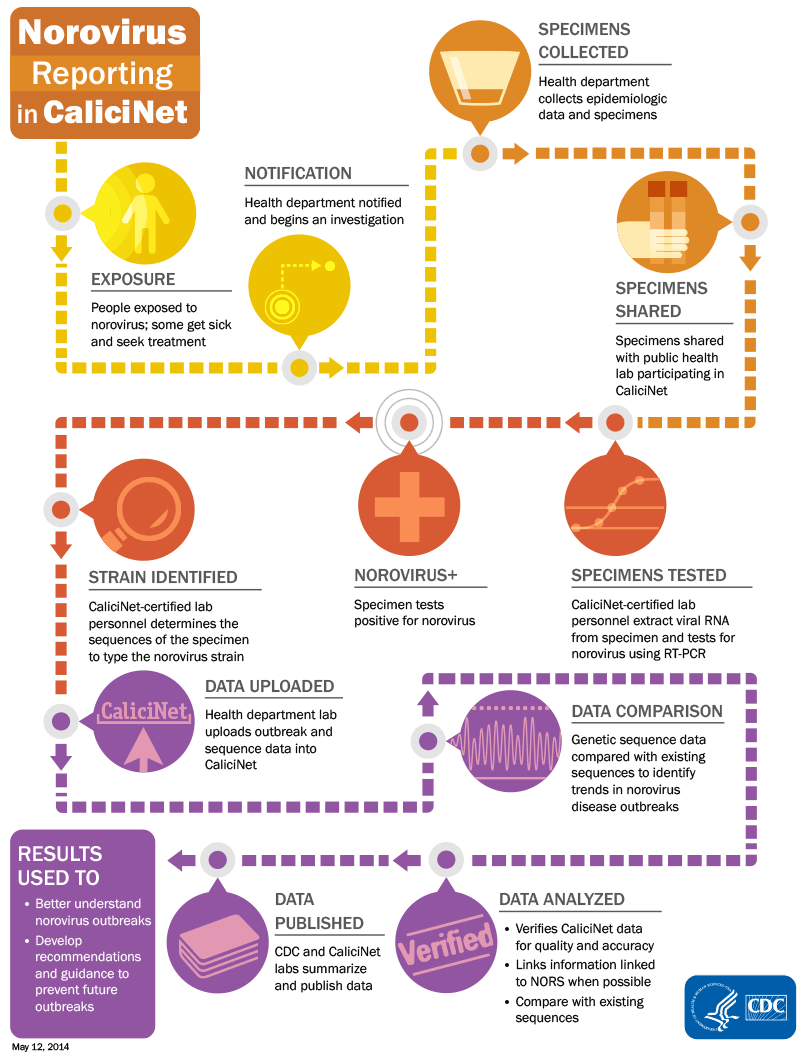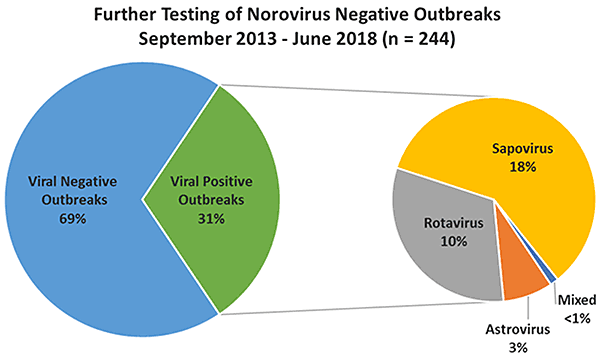Key points
- CaliciNet is a national norovirus outbreak surveillance network of public health laboratories in the United States, coordinated by CDC.
- The database helps CDC better understand noroviruses and develop interventions to prevent them from spreading.

About CaliciNet
CaliciNet focuses on:
CaliciNet is a national norovirus outbreak surveillance network of federal, state, and local public health laboratories in the United States. CDC launched CaliciNet in 2009 to collect information on norovirus strains associated with gastroenteritis outbreaks in the United States.
About caliciviruses
Noroviruses, together with sapoviruses, are part of the family Caliciviridae or caliciviruses that cause diarrheal disease.
The name calicivirus is derived from the cup-shaped depressions seen on the virus particles when viewed using an electron microscope.
Public health impact
Through CaliciNet, participating public health laboratories identify norovirus strains that cause gastroenteritis outbreaks. This is critical for linking outbreaks to a common source, such as:
- Contaminated food
- Monitoring circulating strains
- Identifying new emerging strains, such as GII.P16-GII.4 Sydney
The information collected through CaliciNet helps public health professionals better understand noroviruses and develop interventions to prevent them from spreading.
CaliciNet data and reporting
Participating public health laboratories use standardized laboratory protocols to examine the genetic makeup of norovirus strains. These laboratories electronically submit laboratory data to the CaliciNet database.

Types of data collected
The CaliciNet database includes:
- Genetic sequences of norovirus strains associated with gastroenteritis outbreaks in the United States.
- Basic epidemiologic data from outbreaks. This includes transmission route, outbreak location, and patient demographic data.
Use of data
The data on norovirus strains are compared with existing norovirus sequences in the CaliciNet database. This information can be used to help CDC:
- Link clusters of norovirus illness to a common source, such as contaminated food
- Standardize typing of norovirus strains
- Monitor circulating strains
- Detect and identify new emerging strains of norovirus
Access to data
Only local, state and federal public health laboratories participating in CaliciNet can access the data. CaliciNet-certified public health laboratories must first get permission from CDC to use the data in studies. All data in the CaliciNet database are securely submitted. CDC does not distribute any information about specific people or facilities involved in norovirus outbreaks.
CaliciNet data are shared with public health professionals, health departments, and the general public through scientific publications, presentations, and CDC website.
Participating laboratories
Participation in CaliciNet is limited to federal, state, and local public health laboratories in the United States who either:
- Complete a CaliciNet certification process to actively participate in the network.
- Partner with a certified CaliciNet Outbreak Support Centers (CN-OSCs) or CDC's National Calicivirus Laboratory to report norovirus outbreak data to CaliciNet. There are currently NC-OSCs in California, Idaho, New York, Tennessee, and Wisconsin.
Laboratories participating in CaliciNet must pass a proficiency test bi-annually to maintain certification.
Number of labs certified to participate in CaliciNet
Unexplained viral diarrhea outbreak support centers
Three CaliciNet laboratories serve as Unexplained Viral Diarrhea Outbreak Support Centers (UVD-OSCs) including state health laboratories in California, Minnesota and Oregon. These UVD-OSC sites are tasked to test stool specimens from norovirus negative outbreaks—submitted by CaliciNet laboratories—for other viral enteric pathogens including:
- Rotavirus
- Sapovirus
- Astrovirus
- Adenovirus
Virus-positive samples are genotyped and virus-negative samples are further tested by next generation sequencing for pathogen discovery.

Relationship to other reporting systems
NORS
CDC links laboratory data collected through CaliciNet with clinical and epidemiologic data obtained through the National Outbreak Reporting System (NORS). This helps enhance investigation of norovirus outbreaks and monitoring of outbreak trends. NORS is a surveillance system to report clinical and epidemiologic data for all enteric disease outbreaks (including norovirus); and waterborne outbreaks of non-enteric disease.
NoroSTAT
Several CaliciNet labs are also involved in CDC's NoroSTAT, a system designed to improve the timeliness; completeness; and consistency of norovirus outbreak reporting. NoroSTAT links data from National Outbreak Reporting System (NORS) and CaliciNet to quickly evaluate and compare outbreak activity and characteristics.
Cooperative agreement
CaliciNet is supported by CDC's Food Safety Program through the Epidemiology and Laboratory Capacity (ELC) Cooperative Agreement. This cooperative agreement aims to enhance the capacity of state, local, and territorial health departments to effectively detect; respond; prevent; and control known and emerging (or re-emerging) infectious diseases.

